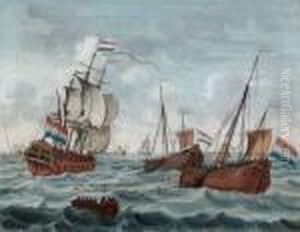Abraham Van Der Salm Paintings
Abraham van der Salm was a Dutch Golden Age painter, known for his detailed landscapes and cityscapes. Born in 1640 in Gouda, in the Netherlands, van der Salm was part of a period in Dutch art characterized by a great interest in naturalism and the depiction of everyday life. While the exact details of his early life and training are somewhat obscure, it is known that he was active in the artistic circles of his hometown and later, in Amsterdam, where he moved to further his career.
Van der Salm's work is characterized by its meticulous attention to detail, vibrant use of color, and the ability to capture the play of light and shadow. He was particularly adept at painting scenes that depicted the Dutch countryside, including pastoral landscapes, farms, and riverscapes. His cityscapes of Amsterdam and Gouda are notable for their historical accuracy and the way they convey the architectural beauty of these cities during the 17th century.
Despite his talent, Abraham van der Salm did not achieve the same level of fame as some of his contemporaries, such as Rembrandt or Vermeer. However, his work was appreciated by art collectors and connoisseurs during his lifetime and has gained more recognition in recent years for its contribution to the Dutch Golden Age of painting. Van der Salm's paintings are now considered valuable for their artistic merit as well as their historical value in depicting the Dutch landscape and urban life of his era.
He continued to paint and contribute to the Dutch art scene until his death in 1720. Today, Abraham van der Salm's works can be found in various museums and private collections, where they are appreciated for their beauty and historical significance.
